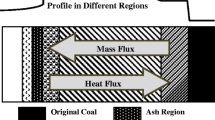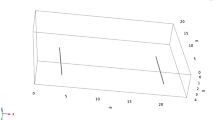Abstract
Underground coal gasification (UCG) has been identified as an environmentally friendly technique for gasification of deep un-mineable coal seams in situ. This technology has the potential to be a clean and promising energy provider from coal seams with minimal greenhouse gas emission. The UCG eliminates the presence of coal miners underground hence, it is believed to be a much safer technique compared to the deep coal mining method. The UCG includes drilling injection and production wells into the coal seam, igniting coal, and injecting oxygen-based mix to facilitate coal gasification. Produced syngas is extracted from the production well. Evolution of a cavity created from the gasification process along with high temperature as well as change in pore fluid pressure causes mechanical changes to the coal and surrounding formations. Therefore, simulation of the gasification process alone is not sufficient to represent this complex thermal-hydro-chemical–mechanical process. Instead, a coupled flow and geomechanical modeling can help better represent the process by allowing simultaneous observation of the syngas production, advancement of the gasification chamber, and the cavity growth. Adaptation of such a coupled simulation would aid in optimization of the UCG process while helping controlling and mitigating the environmental risks caused by geomechanical failure and syngas loss to the groundwater. This paper presents results of a sequentially coupled flow-geomechanical simulation of a three-dimensional (3D) UCG example using the numerical methodology devised in this study. The 3D model includes caprock on top, coal seam in the middle, and another layer of rock underneath. Gasification modeling was conducted in the Computer Modelling Group Ltd. (CMG)’s Steam, Thermal, and Advanced processes Reservoir Simulator (STARS). Temperature and fluid pressure of each grid block as well as the cavity geometry, at the timestep level, were passed from the STARS to the geomechanical simulator i.e. the Fast Lagrangian Analysis of Continua in 3 Dimensions (FLAC3D) computer program (from the Itasca Consulting Group Inc.). Key features of the UCG process which were investigated herein include syngas flow rate, cavity growth, temperature and pressure profiles, porosity and permeability changes, and stress and deformation in coal and rock layers. It was observed that the coal matrix deformed towards the cavity, displacement and additional stress happened, and some blocks in the coal and rock layers mechanically failed.











Similar content being viewed by others
References
Advani SH, Zane Shuck L, Lin YT et al (1976) Thermomechanics simulations associated with underground coal gasification. U.S. Symposium on Rock Mechanics (USRMS), Snow Bird, UT, pp 25–27
Advani SH, Lin YT, Zane Shuck L (1977) Thermal and structural response evaluation for underground coal gasification. SPE J 17(6):413–422
American Society of Mechanical Engineers (2009) ASME international steam tables for industrial use, 2nd edn. ASME, New York
Anthony DB, Howard JB (1976) Coal devolatilization and hydrogasification. AICHE J 22(4):625–656, as reported by Kariznovi M et al. 2013
Bartel LC, Beard SG, Beckham LW et al (1976) Instrumentation results from an in-situ coal gasification experiment. SPE Annual Fall Technical Conference and Exhibition, Louisiana, pp 3–6
Burton E, Friedmann J, Upadhye R (2007) Best practices in underground coal gasification. Lawrence Livermore National Laboratory, University of California, Draft
Buscheck TA, Hao Y, Morris JP et al (2009) Thermal-hydrological sensitivity analysis of underground coal gasification. International Pittsburgh Coal Conference, Pittsburgh, pp 20–23
Computer Modelling Group (2012) STARS User’s guide, 2012. Computer Modelling Group, Calgary, Alberta, Canada
Couch RG (2009) Underground Coal Gasification. IEA Clean Coal Centre
Dabbous MK, Reznik AA, Taber JJ et al (1974) The permeability of coal to gas and water. SPE J 14(6):563–572
Daggupati S, Mandapati RN, Mahajani SM et al (2010) Laboratory studies on combustion cavity growth in lignite coal blocks in the context of underground coal gasification. Energy 35:2374–2386
Fausett LV (1984) An analysis of mathematical models of underground coal gasification. PhD Dissertation, University of Wyoming
Gash BW, Volz RF, Potter G et al. (1992) The effects of cleat orientation and confining pressure on cleat porosity, permeability and relative permeability in coal. Paper presented at the 1992 SCA Conference paper number 9224
Glass RE (1984) The thermal and structural properties of a hanna basin coal. Journal of Energy Resources Technology, ASME 106:266–271
Itasca Consulting Group Inc (2009) FLAC3D User’s guide, 2009. Itasca Consulting Group Inc, Minneapolis, Minnesota
Jung KS (1987) Mathematical modeling of cavity growth during underground coal gasification. PhD Dissertation, University of Wyoming
Kariznovi M, Nourozieh H, Abedi J et al (2013) Simulation study and kinetic parameter estimation of underground coal gasification in Alberta reservoirs. Chemical Eng Research and Design 91(3):464–476
Kostur K, Kacur J (2008) The monitoring and control of underground coal gasification in laboratory conditions. Acta Montan Slovaca 13:111–117
Luo X, Tan Q, Luo C et al (2008) Microseismic monitoring of burn front in an underground coal gasification experiment. U.S. Rock Mechanics Symposium (USRMS), San Francisco
Morris JP, Buscheck TA, Hao Y (2009) Coupled geomechanical simulations of UCG cavity evolution. International Pittsburgh Coal Conference, Pittsburgh, pp 20–23
Nitao JJ, Camp DW, Buscheck TA et al (2011) Progress on a new integrated 3-D UCG simulator and its initial application. International Pittsburgh Coal Conference, Pittsburgh, pp 12–15
Nourozieh H, Kariznovi M, Chen Z et al (2010) Simulation study of underground coal gasification in Alberta reservoirs: geological structure and process modeling. Energy Fuels 24(6):3540–3550
Sansgiry PS (1990) A numerical technique to track the growth of cavities in underground coal gasification. PhD Dissertation, University of Wyoming
Sarraf Shirazi A (2012) CFD simulation of underground coal gasification. MSc Dissertation, University of Alberta
Seifi M, Chen Z, Abedi J (2011) Numerical simulation of underground coal gasification using the CRIP method. The Canadian J of Chemical Eng 89:1528–1539
Settari A, Walters DA (2001) Advances in coupled geomechanical and reservoir modeling with applications to reservoir compaction. SPE J 6(3):334–342
Stanczyk K, Kapusta K, Wiatowski M et al (2012) Experimental simulation of hard coal underground gasification for hydrogen production. Fuel 91:40–50
Synfuels SH (2012) Swan Hills in-situ coal gasification technology development; final outcomes report. Swan Hills Synfuels, Alberta, Canada
Thorsness CB, Grens EA, Sherwood A (1978) A one-dimensional model for in situ coal gasification. National Laboratory (LLNL) Report, Berkeley, UCRL-52523, Lawrence Livermore
Vorobiev OY, Morris JP, Antoun TH et al (2008) Geomechanical simulations related to UCG activities. International Pittsburgh Coal Conference, Pittsburgh
World Energy Council (2010) 2010 survey of energy resources. World Energy Council, London, UK
Yang L (2004) Study on the model experiment and numerical simulation for underground coal gasification. Fuel 83:573–584
Zhao Y, Qu F, Wan Z et al (2010) Experimental investigation on correlation between permeability variation and pore structure during coal pyrolysis. Transp Porous Media 82(2):401–412
Acknowledgments
The authors would like to thank The Canadian Centre for Clean Coal/Carbon and Mineral Processing Technologies (C5MPT) for providing financial support for this research. Also contribution by Dr. Ranjender Gupta’s research group at the University of Alberta is highly appreciated.
Author information
Authors and Affiliations
Corresponding author
Rights and permissions
About this article
Cite this article
Akbarzadeh, H., Chalaturnyk, R.J. Sequentially coupled flow-geomechanical modeling of underground coal gasification for a three-dimensional problem. Mitig Adapt Strateg Glob Change 21, 577–594 (2016). https://doi.org/10.1007/s11027-014-9583-2
Received:
Accepted:
Published:
Issue Date:
DOI: https://doi.org/10.1007/s11027-014-9583-2




